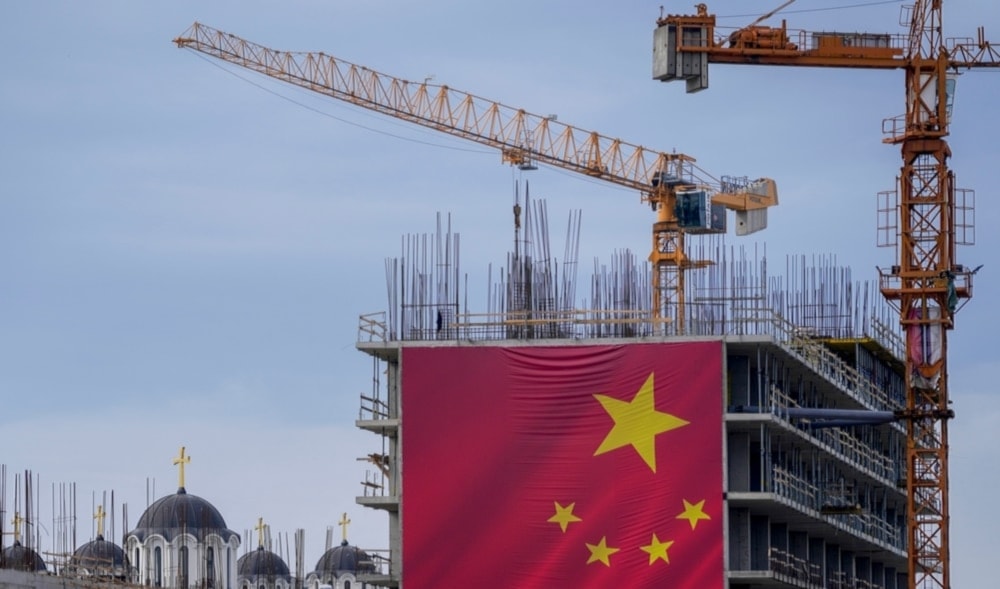China counters Trump, imposes tariffs in tit-for-tat move
In a sharp escalation of the trade war, President Donald Trump's 10% tariffs on Chinese imports triggered an immediate response from China.
-

A giant Chinese national flag is seen on a building in front of a church during a welcome ceremony for Chinese President Xi Jinping at the Serbia Palace in Belgrade, Serbia, on May 8, 2024. (AP)
In response to the US implementing a new 10% tariff on Chinese imports, China quickly retaliated on Tuesday by imposing its own tariffs on select American goods, reigniting the trade war between the world's two largest economies.
The US tariffs, which came into effect at 12:01 am ET on Tuesday (0501 GMT), prompted China’s Finance Ministry to announce new levies. These include a 15% tariff on US coal and liquefied natural gas (LNG), and 10% tariffs on crude oil, agricultural machinery, and certain cars, effective from February 10.
China also launched an anti-monopoly investigation into Google and added two US companies—PVH Corp (owner of brands like Calvin Klein) and biotech company Illumina—to its "unreliable entities list." Additionally, China’s Commerce Ministry and Customs Administration imposed export controls on critical materials like tungsten, tellurium, and ruthenium, necessary for industrial and clean energy applications, to "safeguard national security interests."
While President Trump previously suspended a threat of 25% tariffs on Mexico and Canada over the weekend, offering a 30-day pause for additional border enforcement, no such reprieve came for China. A White House spokesperson confirmed that Trump would not engage with Chinese President Xi Jinping until later in the week.
During his first term, Trump initiated a two-year trade war with China in 2018, driven by concerns over its trade surplus with the US and unfair practices. This conflict saw tariffs on hundreds of billions of dollars worth of goods, disrupting global supply chains and hurting the world economy.
China and the US had agreed in 2020 on a trade deal in which China pledged to buy $200 billion more in US goods, but the pandemic derailed that plan. China’s trade deficit with the US grew to $361 billion last year, according to new customs data.
As the trade war intensifies, Oxford Economics downgraded China’s economic growth forecast, noting the high probability of further tariffs. Trump has made it clear that he will increase tariffs further unless China acts to halt the alleged flow of fentanyl, a deadly opioid, into the US. "China hopefully is going to stop sending us fentanyl, and if they’re not, the tariffs are going to go substantially higher," he said on Monday.
China, however, maintains that fentanyl is an American problem and vowed to challenge the US tariffs at the World Trade Organization (WTO), while also leaving the door open for negotiations.
Stocks in Hong Kong fell after China's retaliation, as Gary Ng, senior economist at Natixis, warned, "Unlike Canada and Mexico, it is clearly harder for the U.S. and China to agree on what Trump demands economically and politically. Even if the two countries can agree on some issues, tariffs may continue to be used as a recurrent tool, which could lead to significant market volatility this year."
Relief for neighbors
Meanwhile, Canada and Mexico secured a temporary reprieve from the 25% tariffs that were set to take effect on Tuesday. Both countries agreed to enhance border enforcement to tackle drug smuggling and immigration, avoiding immediate economic disruption.
Canadian Prime Minister Justin Trudeau and Mexican President Claudia Sheinbaum said they had reached agreements with Trump to step up efforts to combat crime and drugs, with Mexico deploying 10,000 National Guard members to its northern border. Canada will also ramp up efforts against organized crime and fentanyl trafficking.
As for Europe, Trump has hinted that the EU could be next, but EU leaders have stated they are prepared to retaliate if tariffs are imposed, stressing the importance of negotiations. The EU is America’s largest trade partner, and Trump suggested that Britain, having left the EU, might be spared from tariffs.
Trump acknowledged that tariffs may cause short-term pain for US consumers but insisted that it is necessary to curb immigration and narcotics trafficking while promoting domestic industries. However, ING analysts noted that the tariffs would cover nearly half of all US imports, a task that would require the US to dramatically increase manufacturing output, which is currently unfeasible.
Analysts warned that the tariffs could push Canada and Mexico into a recession and risk triggering stagflation in the US, characterized by high inflation, stagnant growth, and rising unemployment.
Read next: China has a trillion-dollar advantage in any tariff battle: WSJ

 4 Min Read
4 Min Read








